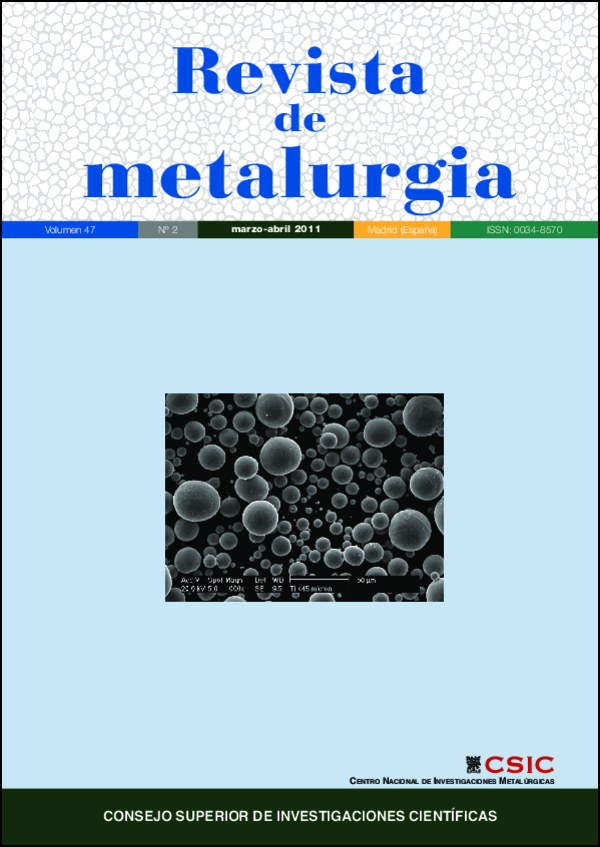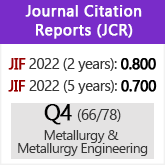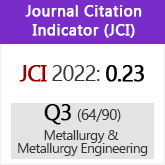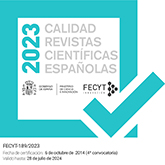Evidence for artificial magnetite coating on Iberian armoury
DOI:
https://doi.org/10.3989/revmetalmadrid.0933Keywords:
Iberian armoury, Early iron, SEM, Falcate, Artificial magnetite layer, ArchaeometallurgyAbstract
A metallographic study of two pre-roman Iberian arms, affected by a cremation process, revealed the presence of an outer magnetite layer, providing highly protective properties. This layer is extraordinarily tenacious and of very homogeneous thickness, indicating an intentional manufacturing process rather than an accidental formation during the severe heating/cooling cycles the artefact suffered. Up to date, the intentional production of these types of layers has been attributed to a welding process of three different metallic sheets, here an alternative model is proposed, allowing, as could be simulated in the laboratory, the virtually exclusive formation of a magnetite coating.
Downloads
References
[1] M.B. Deamos y T. Chapa Brunet, La Edad del Hierro, Ed. Síntesis, S.A. Madrid, España, 1997, pp. 153-182.
[2] M. Almagro, O. Arteaga, M. Blech, D. Ruíz Mata y M. Schubart, Chapter 5: Segunda edad del hierro, in Protohistoria de la Península Ibérica, Ed. Ariel, S.A., Barcelona, España, 2001, pp. 329-357.
[3] F. Quesada Sanz, Arma y símbolo: La Falcata Ibérica, Ed. Instituto de Cultura Juan Gil- Albert, Alicante, España, 1992, pp. 43-87. [4] A.J. Lorrio Alvarado, S. Rovira Llorens y F. Gago Blanco, Lucentum. XVII-XVIII, (1998/1999) 149-161.
[5] J.M. García Cano y M. Gómez Ródenas, Gladius 26 (2006) 61-92. doi:10.3989/gladius.2006.3
[6] Polibio, Historia de Roma (III 114, 2-4), Ed. Alianza, Madrid, 2008, pp.58-60.
[7] Polibio, Historia de Roma (VI, 23), Ed. Alianza, Madrid, 2008, pp.120.
[8] Diodoro de Sicilia, Biblioteca Histórica (V 33, 2-5), Ed. Gredos, Madrid, 2008, pp. 57-60.
[9] Aulo Gelio, Noches Áticas (II, IX, XIII, 9-17), Ed. Akal/Clásica, Madrid, 2009, pp. 17,48,104.
[10] Tito Livio, Historia de Roma (XXI, 5,5) Ed. Alianza, Madrid, 1992, pp. 223.
[11] L.A. Floro, Compendio de la Historia de Roma (II, 7-9), Ed. Gredos, Madrid, 2000, pp. 78-79.
[12] A.J. Criado, W. Engel, N. Eisenreich, V. Kolarik y M. Juez-Lorenzo, J. Phys. III, (1992) 357-362.
[13] R. Dieckmann, Berichte der Bunsen - Gesellschaft fur Physikalische Chemie 86 (1982) 112-118.
[14] R. Dieckmann, Relationships Between Defect Structure, Transport Properties and the Growth Rate of Dense Magnetite Scales During Simple Reactions in the System Iron-Oxygen, in: High Temperature Corrosion, Ed. R.A. Rapp, Houston, Texas, 1983, pp. 70-75.
[15] R. Dieckmann y H. Schmalzried, Berichte der Bunsen-Gesellschaft fur Physikalische Chemie 81 (1977) 344-347.
[16] R. Dieckmann y H. Schmalzried, Berichte der Bunsen-Gesellschaft fur Physikalische Chemie 81, (1977) 414-419.
[17] M. Juez-Lorenzo, V. Kolarik, N. Eisenreich, W. Engel y A.J. Criado, Proceedings of the Second European Powder Diffraction Conference, 1992, Vol. 2, R. Delhez, E.J. Mittemeijer (Eds.) Aedermannsdorf Trans Tech Publications, Enschede, The Netherlands, 1993, pp. 560-574.
[18] M. Juez-Lorenzo, V. Kolarik, N. Eisenreich, W. Engel y A.J. Criado, J. Phys. IV, (1993) 461-467.
[19] H.H. Coghlan, Sibrium 3 (1956-57) 167-174.
[20] J. Alonso, Actas de Metalespaña Madrid, España, 2008, J. Barrio y E. Cano (Eds.) UAM, Madrid, España, 2009, pp.134-142.
[21] A. Madroñero de la Cal, Kalathos (1983-1984) pp. 139-148.
[22] H. SANDARS, The Weapons of the Iberians. Archaeologia or Miscellaneous tracts relating to Antiquity, segunda serie, volumen XIV Ed. Facsímil, Oxford, England, 1913, pp. 205-294.
[23] E. Cabré de Morán y M.I. Baquedano Beltrán, La Guerra en la Antigüedad, una aproximación a origen de los ejercitos en Hispania, Ed. Fundación Caja Madrid, Ministerio de Defensa, Madrid, 1997, pp. 240-259.
[24] J. Alonso, I. Filloy y R. Cerdán, Nuevas técnicas metalúrgicas en armas de la II Edad del Hierro, Ed. Foru-Aldundía, Diputación Foral de Álava, España, 1999, pp. 124-131.
[25] A.J. Criado, A. Martínez, R. Calabrés, A. García, F. Penco y J.A. Lecanda, Análogos Arqueológicos e industriales para almacenamientos profundos: estudio de piezas arqueológicas metálicas, Archeo I. ENRESA, Publicación Técnica 00/07, Madrid, España, 2000, pp. 1-204.
[26] A.J. Criado, J.A. Martínez García y E. Bravo Muñoz, Análogos arqueológicos e industriales para almacenamientos profundos: estudio de piezas arqueológicas metálicas. Archeo II. ENRESA, Publicación Técnica 03/03, Madrid, España, 2003, pp. 1-276.
[27] S. Enzo, M. Bazzoni, V. Mazzarello, G. Piga, P. Bandiera y P. Melis, J. Archaeol. SCI 37 (2007) 1731-1737. doi:10.1016/j.jas.2006.12.011
[28] C. Wells 1960, Antiquity 34 (1960) 29-37.
[29] J.L. McKinley, Proceedings of the Prehistoric Society 63, Prehistoric Society, Royaume-Uni, London, England, 1997, pp. 129-145.
[30] S. Hummel, H. Schutkowski y B, Herrmann, Actes des 3ieme Journees Anthropologiques, Note et Monographies Techniques 24 Valbonne, CNRS, Ed. Paris, Francia, 1988, pp. 177-194.
[31] J, Piaskowski, J. Iron Steel Res. Int. 198 (1961) 263-282.
[32] G.R. Booker, J. Norbury y A.L. Sutton, J. Iron Steel Res. Int. 187 (1957) 205-215.
[33] K.H. Liu, H. Chan, M.R. Notis y V.C. Pigott, Microbeam Analysis, A.D. Romig Jr. y J.I. Goldstein (Eds.), San Francisco Press, San Francisco, EE.UU., 1984, pp. 261-263.
[34] G.E. Dieter, Jr., Mechanical Metallurgy, SI metric edition, McGraw-Hill Book Co., New York, EEUU, 1988, pp. 503-563.
[35] F.R. Morral, E. Jimeno y P. Molera, Metalurgia General Tomo II, Ed. Reverté S.A., Barcelona, España, 1985, pp. 1008-1011.
[36] H.A. Wriedt, Binary Alloy Phase Diagrams, ASM International, 2nd edition, Materials Park, OH, EE.UU., 1990, pp. 846-849.
[37] M. Juez-Lorenzo, V. Kolarik, N. Eisenreich, W. Engel y A.J. Criado, J. Phys. IV (1992) 351-357.
[38] M. Juez-Lorenzo, Tesis Doctoral, Facultad de Ciencias Químicas, Universidad Complutense de Madrid, 1993.
[39] V. Kolarik, Doktors der Naturwissenschuften. Hüttenwesen und Geowissenschaften der Rheinisch-Westfälischen Technischen Hochschule Aachen, 1993.
Downloads
Published
How to Cite
Issue
Section
License
Copyright (c) 2011 Consejo Superior de Investigaciones Científicas (CSIC)

This work is licensed under a Creative Commons Attribution 4.0 International License.
© CSIC. Manuscripts published in both the printed and online versions of this Journal are the property of Consejo Superior de Investigaciones Científicas, and quoting this source is a requirement for any partial or full reproduction.All contents of this electronic edition, except where otherwise noted, are distributed under a “Creative Commons Attribution 4.0 International” (CC BY 4.0) License. You may read here the basic information and the legal text of the license. The indication of the CC BY 4.0 License must be expressly stated in this way when necessary.
Self-archiving in repositories, personal webpages or similar, of any version other than the published by the Editor, is not allowed.


















